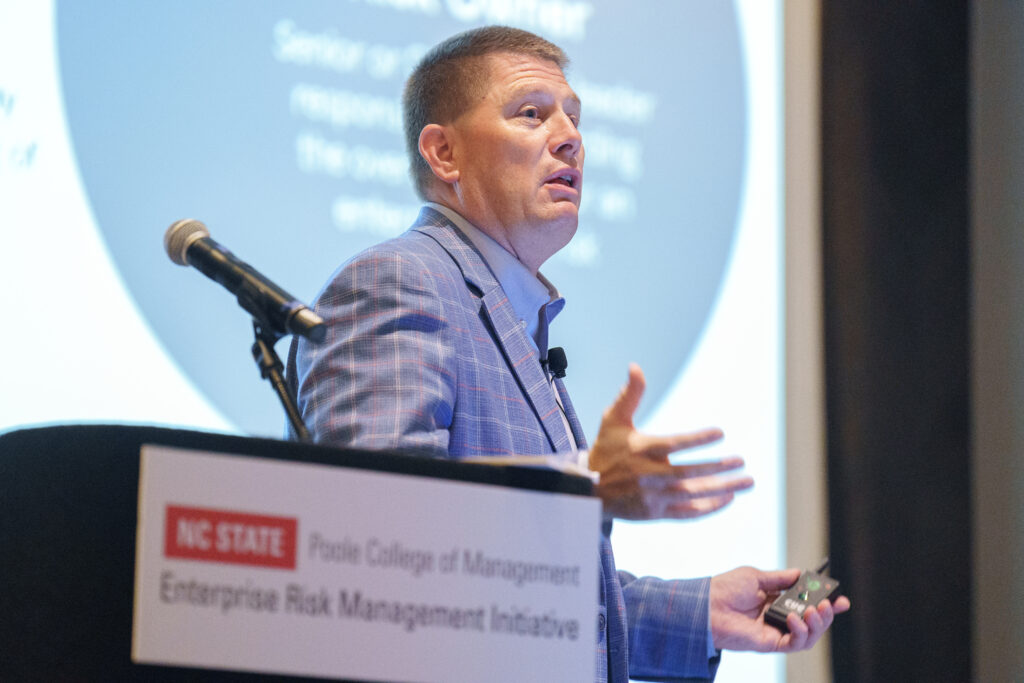Leading the Pack to Turn Risk Into Strategic Advantage
Poole College’s ERM Roundtable Summit gathers risk professionals with innovators from the public and private sectors to discuss leading-edge risk management strategies.

The ballroom at the Renaissance Raleigh North Hills Hotel fell silent as an audience of risk professionals fixated on a video screen. The scene unfolding was nothing short of gripping: a NASCAR race car careened off the track, flipping and spinning wildly before coming to rest as a crumpled, flaming wreck in the infield.
The dramatic footage of driver Ryan Preece’s August 2023 crash set the stage for the Fall 2024 ERM Roundtable Summit, where Eric Jacuzzi, NASCAR’s vice president of vehicle performance, recounted the intense five-week effort to analyze the crash, identify design flaws, and implement solutions to push the boundaries of safety innovation.
“Power, speed, and innovation are the holy trinity of NASCAR,” Jacuzzi told the audience, emphasizing the high stakes of balancing performance with safety in a risk-laden environment.
Hosted by Poole College of Management’s ERM Initiative at NC State, the biannual summit resources organizations with the latest data and best practices in risk management while also facilitating dialogue among risk management practitioners across a wide variety of industries.
It’s not alchemy, but an alignment of leading-edge research, thought leadership and executive education that makes it work.
“It’s all about strategy,” said Mark S. Beasley, the Alan T. Dickson Distinguished Professor of Accounting at NC State, who serves as director of the ERM Initiative.
That strategy is built on a foundation of real-world tools and tactics to help organizations succeed on the ground. The ERM Initiative’s newly updated website includes a searchable resource center with articles, special reports and best practices on hundreds of topics. And it offers templates, tool kits and insights that take the guesswork out of managing risk in a risky world.

Creating Strategies that Evolve
Risk response was on the mind of more than one speaker at the summit.
Dustin Ade has led the transformation of risk management at Chick-fil-A by focusing on business resiliency across the organization. When he took on the challenge in 2018, the fast-growing company took a traditional approach to risk.
“Risk was being managed across the business, but in a very disparate way,” he said. “We wanted to move away from just being effective reactors and move toward being competent responders.”
The first test came while Ade was still building his team and crafting his approach.
“We got in front of our executive committee in 2019, and we were headed into launching a great program with a lot of momentum,” he said. “When COVID hit, we had to learn how to facilitate the greatest disruption that we’ve experienced in our lifetimes while trying to learn how to lead on crisis.”
It was trial by fire.
In the midst of the pandemic, Ade’s team developed a risk partnership network across the global enterprise, connecting staff members responsible for the day-to-day management of enterprise risk with leaders up the chain.
The three-pronged approach ensures that every risk has an executive-level “risk sponsor,” an officer-level “risk owner” and a functional-level “risk
partner.”
The company makes it easy for line managers to report risks through an online app. And it helps risk partners respond to emerging risks through educational resources, such as a monthly Risk Roundup newsletter and a resiliency tool kit. An annual risk assessment survey gives officers and directors an opportunity to weigh in on potential risks before they occur.
With five years of relationship-building and hard-won success under its belt, the business resiliency program is now embraced across Chick-fil-A.
“Folks had to learn and understand that risk is actually a two-sided coin,” Ade said. “There is an opportunity and there’s also a threat. We have to manage both in order to be successful.”
It’s a lesson another speaker at the summit is learning as he wraps up the first year of an ERM refresh at Sherwin-Williams. Aaron Morrow, director of risk management at the global paint and coatings company, tipped his hat to Ade at the beginning of his presentation.
“The good news is that Dustin [Ade] is a couple of years ahead of us. So, a lot of the content that he covered I’m familiar with, but from a beginner’s viewpoint,” he said.
But Sherwin-Williams is fast on its way to catching up with the top ERM innovators. And it has some strategic advantages to ease the path.
“Our employees are the number one stockholder,” Morrow said. “So, keeping our employees safe is a top priority for our organization. Making sure that our employees have the ability to create their possible, to bring their best selves to work, is what drives our activities.”
Even for a beginner, Morrow is tackling the ERM refresh at a speed that would impress NASCAR — on or off the track. He quickly ticked off the twist and turns he’s negotiated in the past year. First, he had to understand the program’s priorities, leadership’s expectations and his team’s
capabilities. He built a relationship map to help prioritize connections across the enterprise. Then came the tough work of balancing short- and long-term goals and providing an unfiltered assessment of risks and options.
All the while he had to provide “air cover” to the teams making day-to-day decisions — whatever the outcome. He sees a fine line between evaluating a process and second-guessing a decision.
“I’m very hesitant to say that we made a wrong decision because one of the things that we deal with in risk management is that at any point in time there’s always uncertainty,” Morrow said. “It’s easy to go back in the future and say, ‘Oh, I should have done this differently.’ But that creates a scenario where you’re only looking at the results and not looking at the process.”

Managing Proactive Risk and Crisis
Dan Florness, CEO of Fastenal, also advocated a forward-looking approach to enterprise risk management. He framed his philosophy of risk in the form of a question: “What risks do we need to start planning for today that we need to solve in the future?”
Fastenal’s ERM approach has been maturing over the past decade, evolving from a fragmented system with disparate monitoring and reporting functions to an integrated enterprise-level organization. The company offers training, creates contingency plans and manages risk management activities such as monitoring, measuring and reporting.
With a background in finance, Florness keeps a close watch on the bottom line. For him, the biggest risk confronting Fastenal is anything that compromises the company’s relationship with its customers.
“We decided as an organization that our number one risk is always going to be product quality,” he explained.
He urged summit participants to create a culture of ERM in their organizations.
“Risk mitigation is a means to be a better partner to your customer, a better partner to your employees, and more responsible in the marketplace,” he said. “That’s why risk is a key within organizations.”
The summit’s final speaker, Mary Cole Pike, addressed the role of crisis communications in risk management. It’s a role she knows well as executive director of communications at NC State.
On a campus with more than 40,000 students and 10,000 employees, a crisis can — and often does — arise without warning.
“It’s important to ensure that in a crisis response, everyone knows the role that they’re playing,” Pike said. “Whether you’re doing that through tabletops or preparation ahead of time or just having these conversations on days when things are not crazy, be prepared.”
Pike advocated having a crisis team that can scale up or down based on the scope of the issue. And she suggested that meetings be kept short, with frequent breaks, to allow participants to complete actions, gather additional information and brief leadership.
“It’s important to ensure that everyone is communicating across the board, not just among the communications team,” she said, “but also with the folks out there doing the work, operationalizing the decisions and making sure the tactics are complete.”
- Categories:


